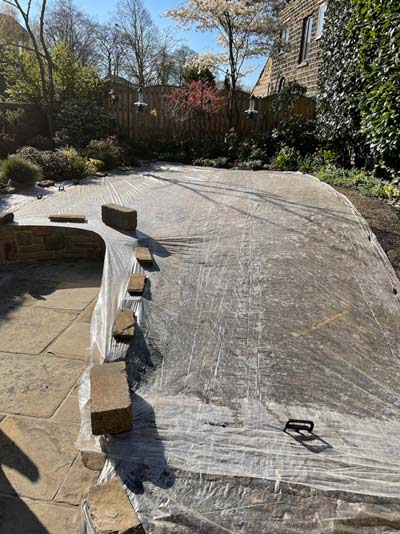
The No 1 Way to Protect Grass Seed
Covering your precious newly planted grass seed with polythene sheeting is not only effective protection from birds but also drying winds and torrential downpours. It is very cheap, easy to lay, and speeds germination.
Covering seed to protect from birds is a great idea, using polythene sheeting is a brilliant idea.
For starters, you don't need to water until you remove the polythene sheet. You can seed in slightly lower temperatures because your polythene sheet is going to have a greenhouse effect and speeding germination. You're also protecting your hard work and investment from weed seeds and also the possibility of a torrential down pour that could wash your seed away.
Covering with polythene sheeting is a must on slopes.
Builders merchants and hardware suppliers sell very large rolls of strong polythene sheeting. At the time of writing in 2022 you get 4m x 25m clear 250 gauge for £16. This means 4 rolls covers a tennis court for just over £60! It's the best protection and insurance for your seed and hard work.
Preparing the Lawn for Seeding
The polythene sheet may need to be down between 7 and 15 days depending on the outside temperature. And, because you're going to cover the lawn with polythene, rain or water will not penetrate so you must ensure enough moisture is in the ground to germinate the seeds BEFORE you cover it.
Do this by heavily watering the prepared ground for several days. You want it wet but not muddy. Now let the surface dry for half a day so that you can walk on it without the soil sticking to your shoes. Wear smooth soled shoes to reduce disturbance of the soil surface.
So, lightly score the soil surface with a rake by just dragging it over the surface. No pressure required and you should only be going a few millimeters deep. Spread your seed, use a light broom to brush the scored soil and seed so you have a smooth surface. Most of the seed will still be visible and should not be buried. Now firm the seed into the soil with a quarter filled water roller or use the lawn mower if it has a roller. Do not have the engine running!
How to Lay Polythene Sheeting

Start by laying to cover one edge of the lawn so that the edge of the polythene is on an adjoining surface. You do not want the edges of the lawn to dry by having insufficient cover. Fix in position with stones or bricks. Do not scrimp as a stiff wind can get underneath and carry the whole lot away! See left side of image.
If your lawn is less than 4m wide then you can cover the lawn with one width but you may need a second sheet alongside if it's wider. Make sure of a good overlap and use ground pegs available from garden centers to peg the sheeting into the soil surface as in the bottom and right hand side of the image.
When Should I Remove the Polythene Grass Seed Cover?
Remove it once most of the seedlings are 3cm long. It won't hurt to stay on longer as long as there is no hot weather.
Can I use Polythene to at any Time of Year?
Hot weather can raise temperatures underneath the polythene to dangerous levels that can literally cook your grass so do not use in the summer. Spring and autumn are the traditional seeding times so this is when to use it. If you are wanting to seed in warmer temperatures consider the same procedure but use a garden fleece instead.
Unfortunately polythene is not going to raise temperatures sufficiently in winter to enable satisfactory germination of seed. Most seed requires at least 10 degrees ground temperature to germinate.